Dindigul biryani recipe with step by step photos – This is an easy to prepare vegetarian version of the Dindigul biryani made with white button mushrooms, rice, aromatics, curd and ghee. It makes for a hearty meal when paired with raita, salad and papad.
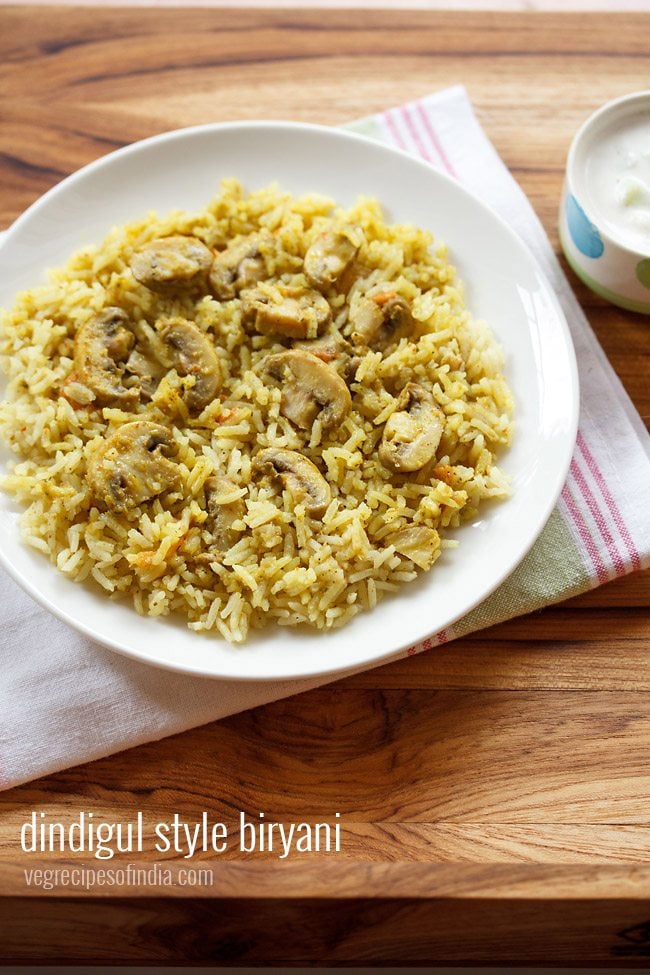
The biryani from Dindigul (a city in Tamil Nadu state) is famous and popular. this biryani is made popular by the Dindigul thalappakatti restaurant, who are also the ones who created this biryani recipe.
I am sharing this recipe after a lot of trying and testing. I have tested this Dindigul style biryani with various ingredients and methods many times. finally I settled for two ways the recipe can be made and both of them are a favorite at home. I make no claim that this biryani tastes exactly as the one served in the Dindigul thalappakatti restaurants. As mentioned above, I make this biryani two ways. One is this method and the other is a slightly different method. Sharing the first version for now.
The original Dindigul thalappakatti is made with mutton or chicken. Being a vegetarian I substitute mushrooms or mixed veggies. If you use soy chunks, you can add them too.
I have shared two more South Indian biryani varieties with mushrooms:
- Ambur biryani (with mushrooms)
- Mushroom biryani (Chettinad style)
For the rice I have used seeraga samba rice. If you do not have seeraga samba rice, then use basmati rice. Mushrooms can be substituted with mixed veggies.
This recipe is not a spicy version. According to your family preferences, you can increase the spiciness by adding more green chilies and spices.
How to make Dindigul Biryani
1. Firstly rinse 1.25 cups seeraga samba rice (245 grams) in water for a couple of times. Then soak rice in enough water for 20 to 30 minutes. After 20 to 30 minutes drain all the water and keep the rice aside.
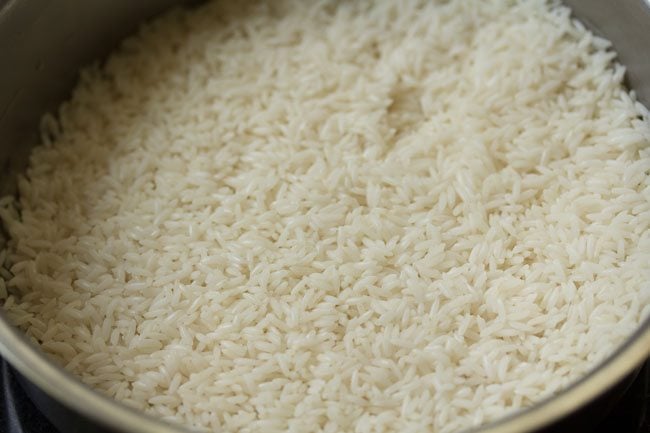
2. When the rice is soaking, prep the other ingredients like chopping onions, tomatoes, mushrooms etc. Then take the following whole spices.
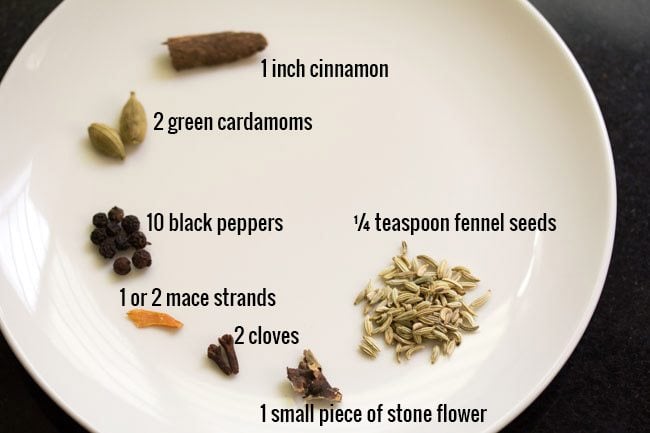
3. Add them in a small grinder jar or coffee grinder and crush them coarsely.
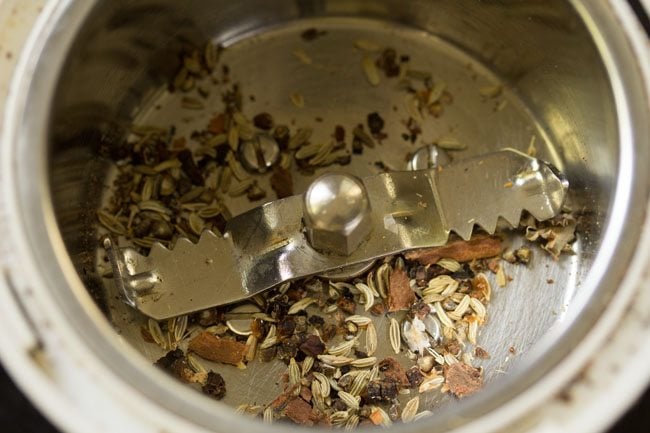
4. Then add the following ingredients:
- 1 cup chopped onion
- 1 or 2 green chillies (chopped)
- ¼ cup chopped coriander leaves
- 2 tablespoons of chopped mint leaves
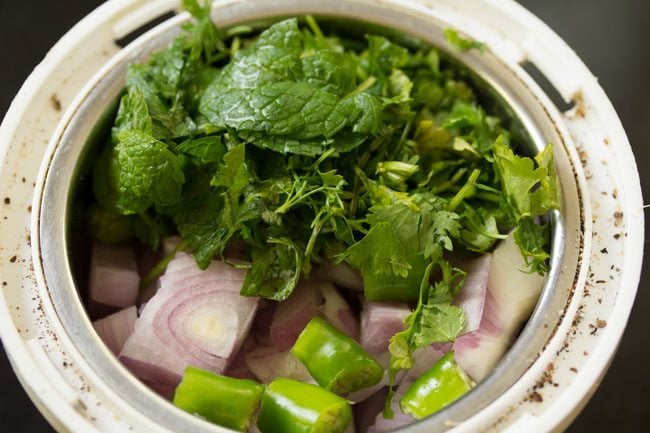
5. Without adding any water grind or blend to a smooth fine paste. The juices from the onions help in blending the ingredients. Hence there is no need to add any water.
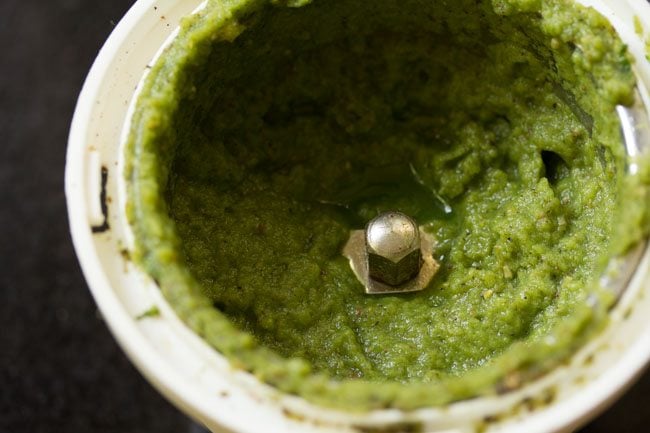
Making Dindigul Biryani
6. Now heat 2 to 2.5 tablespoons of ghee in a pan. Add 1 tej patta (Indian bay leaf) and let it saute for a few seconds on low heat. You can also use half ghee and half oil.
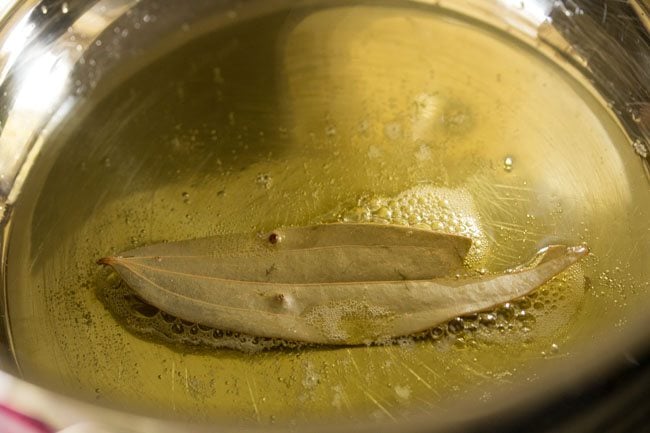
7. Then add the prepared ground paste.
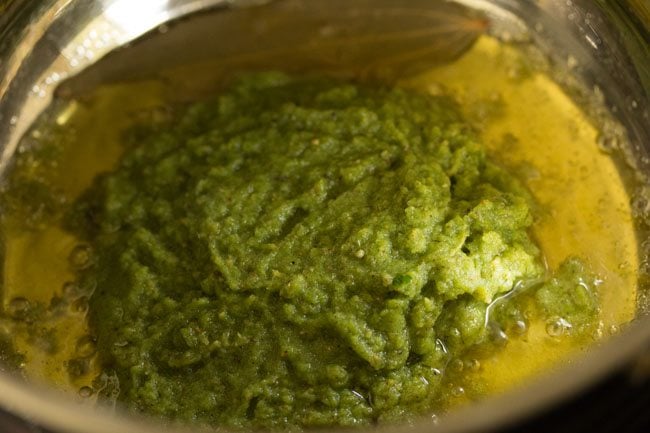
8. Stir and mix well. Begin to saute the paste on a low heat.
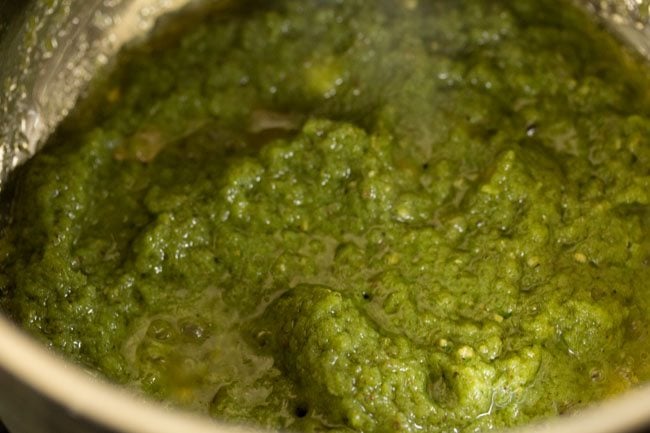
9. On a low heat saute for 4 to 5 minutes or till the color changes and you see ghee releasing at the sides. Stir often while sautéing.
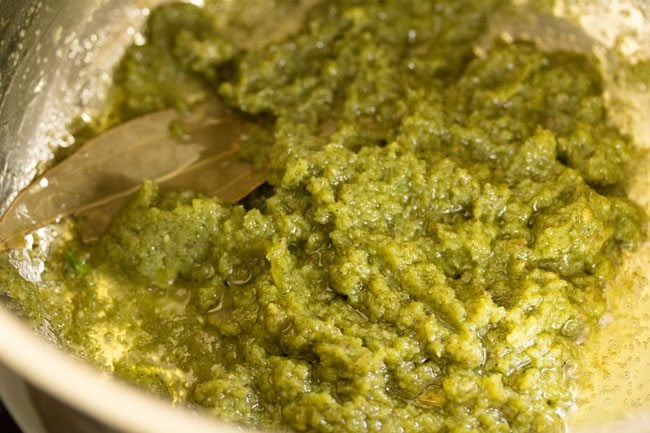
10. Next add 1 teaspoon ginger-garlic paste.
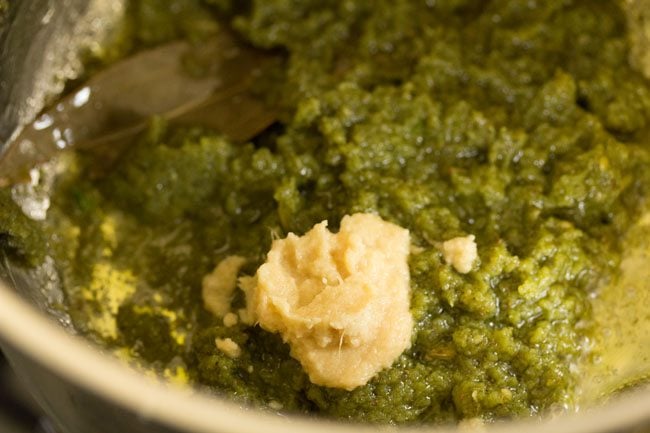
11. Saute for 4 to 5 seconds on low heat.
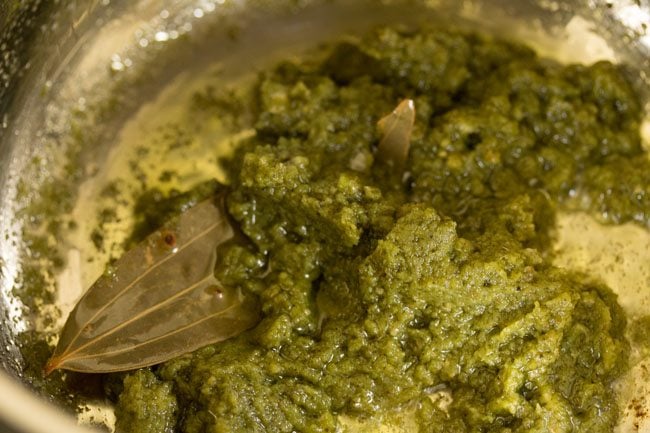
12. Next add ½ cup of chopped tomatoes.
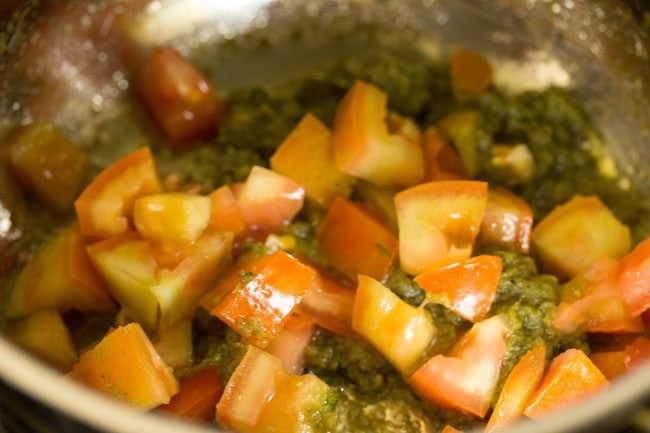
13. Then add the following ground spices:
- ¼ teaspoon turmeric powder
- ¼ teaspoon red chilli powder (or cayenne pepper)
- ½ teaspoon coriander powder
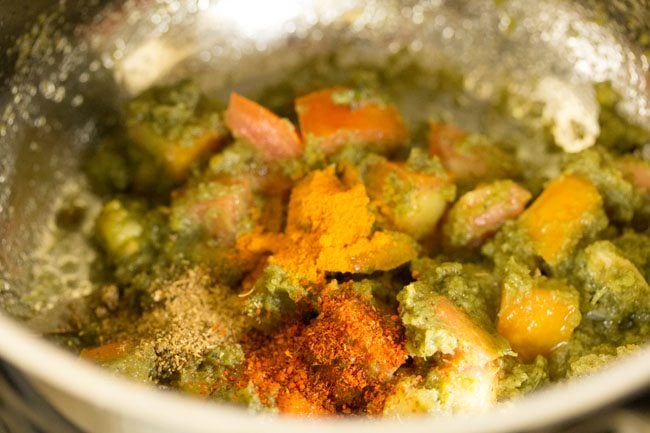
14. Mix very well and saute for 1 to 2 minutes.
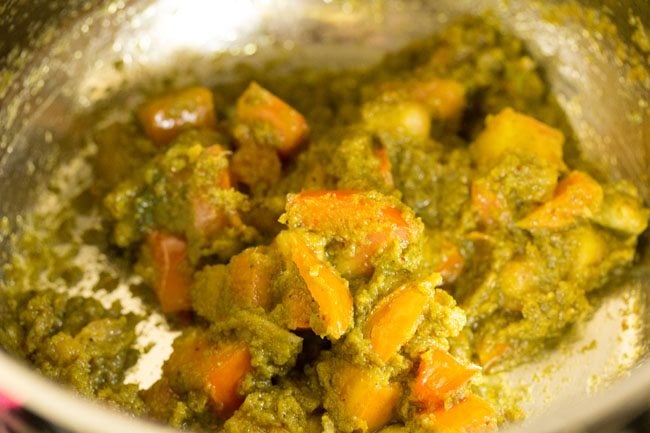
15. Then add 2 cups sliced or chopped white button mushrooms.
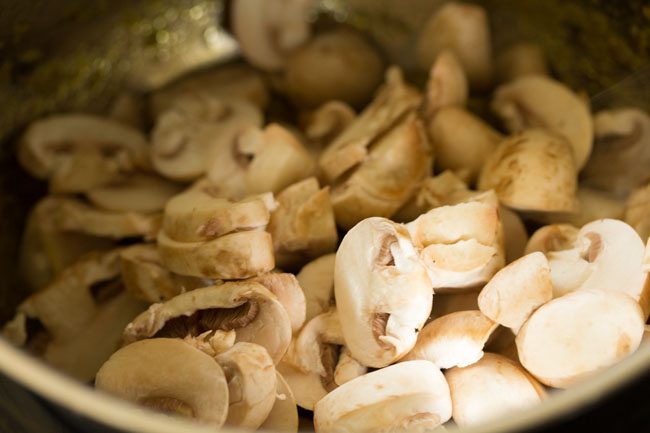
16. Mix well and saute the mushrooms for 2 to 3 minutes.
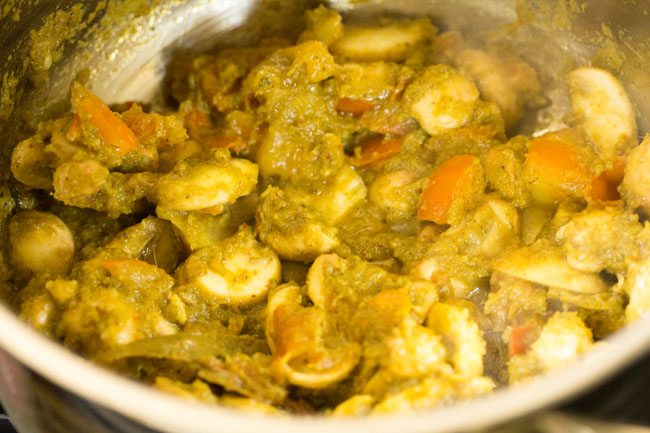
17. Keep the heat to a low and then add ¼ cup fresh curd (yogurt). The curd should be fresh and not very sour.
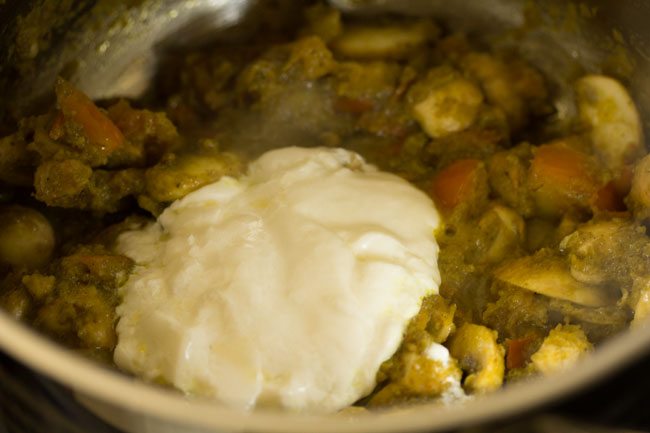
18. As soon as you add the curd, quickly stir and mix well.
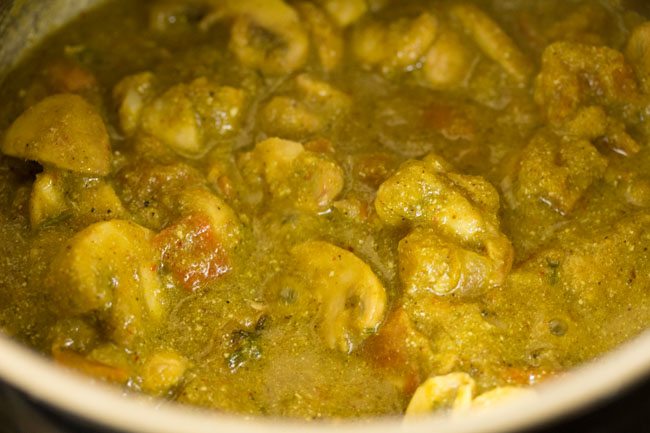
19. Add 2.5 cups of water.
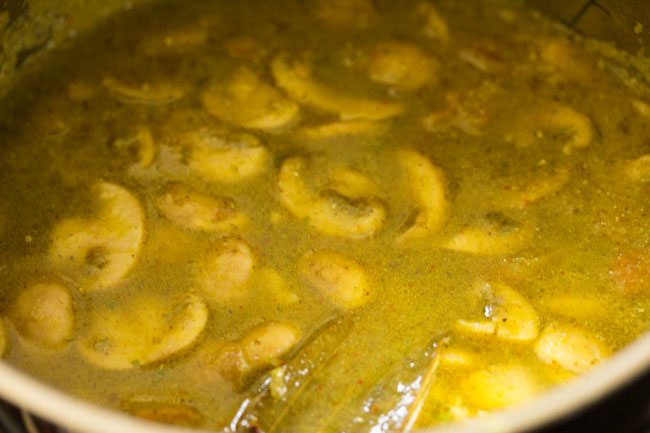
20. Season with salt as required. Stir and mix again. Check the taste of the stock and it should be slightly salty.
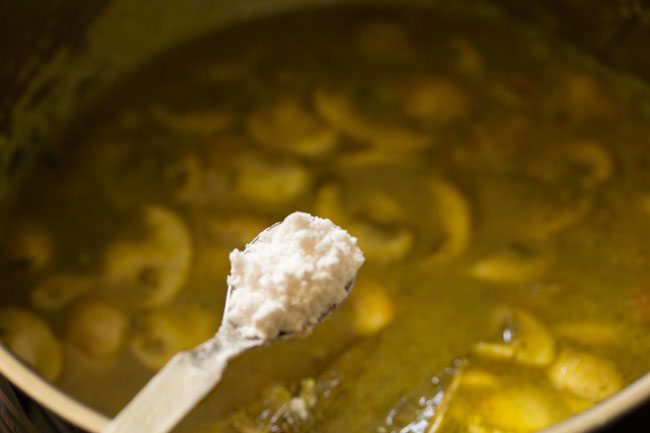
21. Bring the whole gravy to a boil on a medium heat.
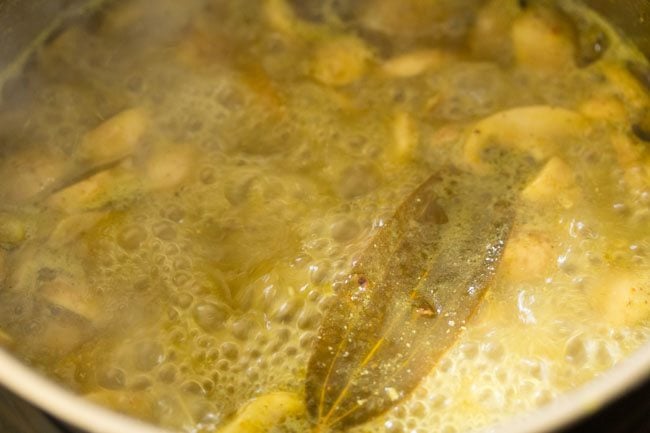
22. Then add the soaked rice.
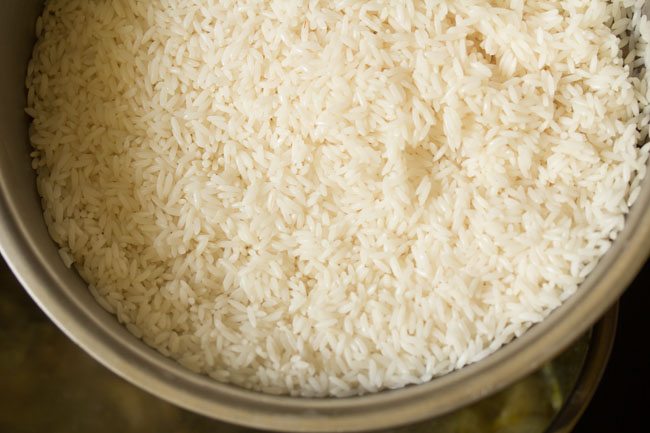
23. Gently stir and mix.
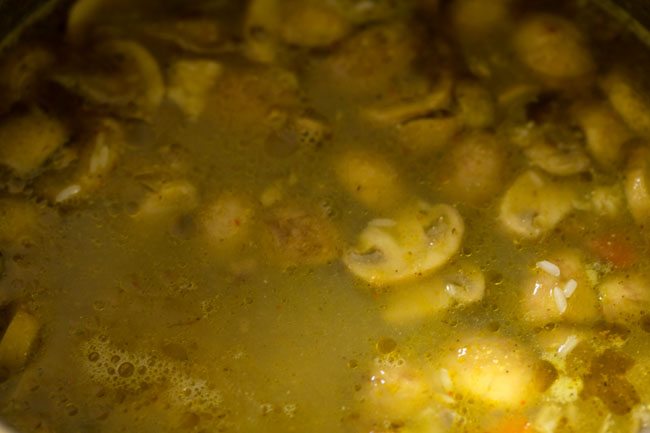
24. Next add 1 teaspoon of lemon juice. Stir again.
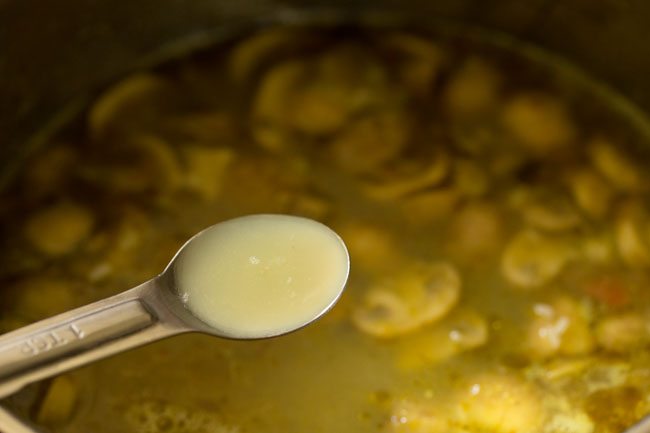
Cooking Dindigul biryani
25. Seal the pan with an aluminum foil.
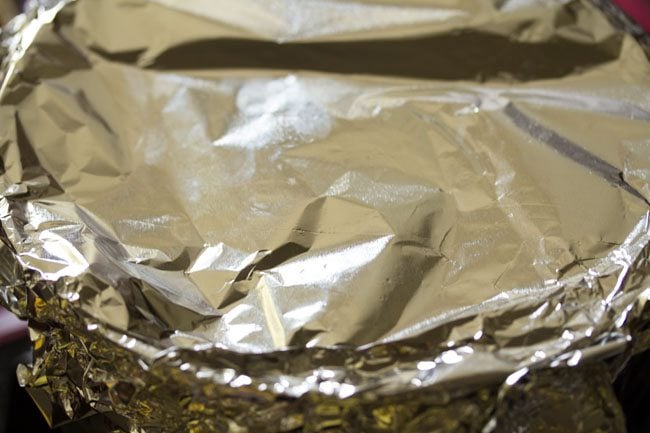
26. Cover with its lid.
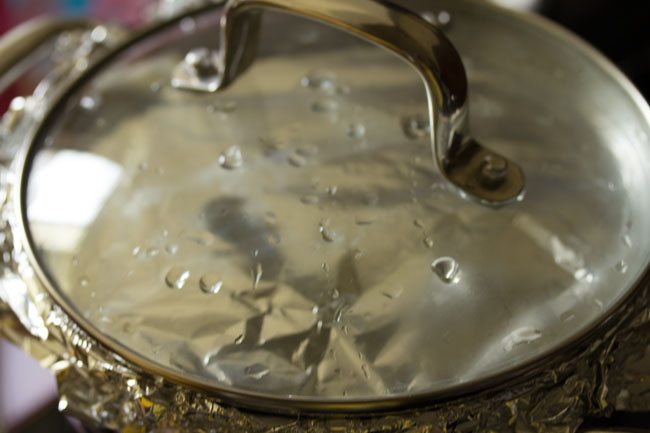
27. On a low flame or sim, dum cook the biryani for 15 to 16 minutes. Do use a thick bottomed heavy pan or else the biryani can get burnt from the bottom.
If in doubt, then place a heavy tawa (griddle) on the stovetop and keep the pan on it.
To check if the biryani is cooked properly first the rice grains should be tender and fluffy. Secondly there should not be any liquid or gravy at the bottom of the pan.
If in case there is any gravy at the bottom of the pan, then continue to dum cook until all the liquids is absorbed by the rice.
Allow the biryani to rest for 5 to 6 minutes and then open the lid. Gently fluff and then serve.
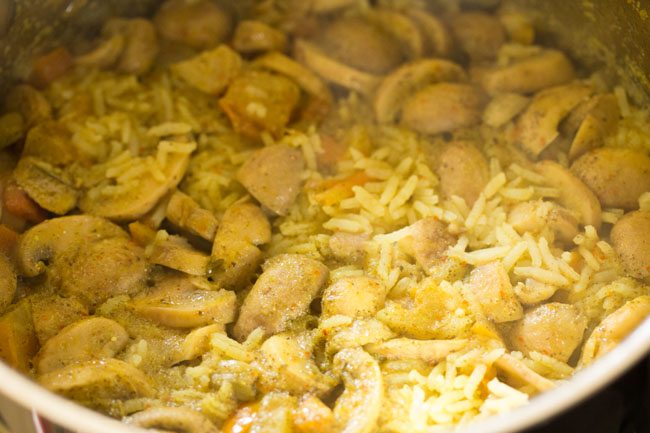
28. Serve Dindigul biryani hot or warm with any raita of your choice. Instead of raita you can also serve it with plain yogurt.
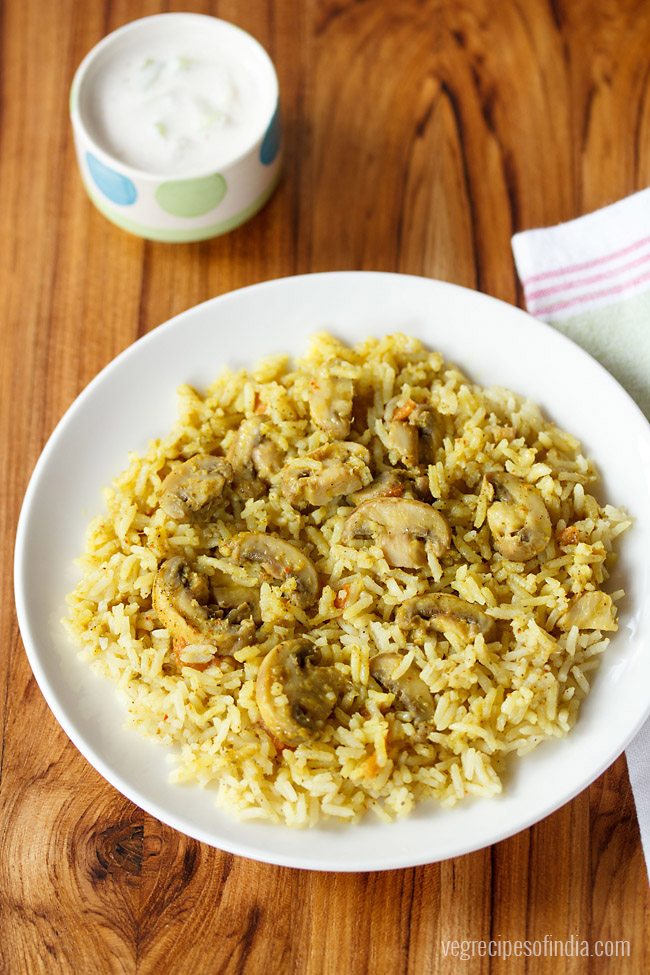
More Biryani varieties
Please be sure to rate the recipe in the recipe card or leave a comment below if you have made it. For more vegetarian inspirations, Sign Up for my emails or follow me on Instagram, Youtube, Facebook, Pinterest or Twitter.
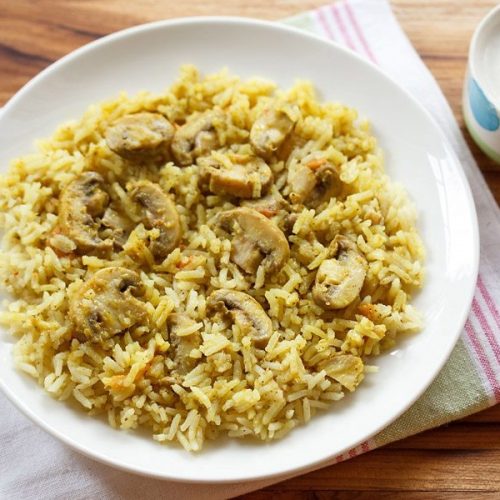
Dindigul Biryani
Ingredients
soaking rice
- 1.25 cups seeraga samba rice or 245 grams seeraga samba rice – can also use basmati rice
- enough water for soaking rice
whole spices
- 2 green cardamoms
- 1 inch cinnamon
- 1 to 2 single strands of mace
- 2 cloves
- 1 small piece of stone flower (dagad phool) – skip if you do not have
- 8 to 10 whole black pepper
- ¼ teaspoon fennel seeds
for green paste
- 1 large onion or 100 to 105 grams onions or 1 cup chopped onion
- 1 or 2 green chillies
- ¼ cup chopped coriander leaves
- 2 tablespoons chopped mint leaves
other ingredients
- 2 to 2.5 tablespoons Ghee or you can also use half ghee and half oil
- 1 tej patta (indian bay leaf)
- 1 teaspoon Ginger Garlic Paste
- ¼ teaspoon turmeric powder
- ¼ teaspoon red chilli powder
- ½ teaspoon Coriander Powder
- 1 large tomato or 100 grams tomato or ½ cup chopped tomato
- 200 grams mushrooms or 2 cups chopped mushrooms
- ¼ cup Curd (yogurt)
- 1 teaspoon lemon juice – optional
- 2.5 cups water
- salt as required
Instructions
soaking rice
- Firstly rinse 1.25 cups seeraga samba rice (245 grams) in water for a couple of times. Then soak rice in enough water for 30 minutes. After 30 minutes drain all the water and keep the rice aside.
- When the rice is soaking, prep the other ingredients like chopping onions, tomatoes, mushrooms etc.
preparing masala paste
- Take the whole spices “mentioned under the list whole spices” in a small grinder jar and grind coarsely.
- Then add 1 cup chopped onion, 1 or 2 green chillies (chopped), ¼ cup chopped coriander leaves and 2 tablespoon chopped mint leaves.
- Without adding any water grind to a smooth paste.
making dindigul biryani
- Now heat 2 to 2.5 tablespoons ghee in a pan. Add 1 tej patta and let it saute for a few seconds. You can also use half ghee and half oil.
- Then add the ground paste.
- Mix well and saute the paste on a low flame for 4 to 5 minutes or till the color changes and you see ghee releasing at the sides.
- Stir often while sautéing. Next add ginger-garlic paste and saute for 4 to 5 seconds.
- Next add chopped tomatoes along with turmeric powder, red chilli powder and coriander powder.
- Mix very well and saute for 1 to 2 minutes.
- Then add 2 cups sliced or chopped white button mushrooms. Mix well and saute the mushrooms for 2 to 3 minutes.
- Keep the flame to a low and then add fresh curd (yogurt). As soon as you add the curd, quickly stir and mix well.
- Add 2.5 cups water. Season with salt as required and mix again. Check the taste of the stock and it should be slightly salty.
- Bring the whole gravy to a boil on a medium heat. Then add the soaked rice and gently mix.
- Next add 1 teaspoon lemon juice. Stir again.
Cooking dindigul biryani
- Seal the pan with an aluminum foil. cover with its lid.
- On a low flame or sim, dum cook the biryani for 15 to 16 minutes. Do use a thick bottomed heavy pan or else the biryani can get burnt from the bottom. If in doubt, then place a heavy tawa (griddle) on the stovetop and keep the pan on it.
- To check if the biryani is cooked properly first the rice grains should be tender and fluffy. Secondly there should not be any liquid or gravy at the bottom of the pan.
- If in case there is any gravy at the bottom of the pan, then continue to dum cook until all the liquids is absorbed by the rice.
- Allow the biryani to rest for 5 to 6 minutes and then open the lid. Gently fluff and then serve.
- Serve dindigul biryani with any raita of your choice.
Notes
- Add more green chilies for a spicy taste.
- Instead of seeraga samba rice, you can use basmati rice.
- Instead of mushrooms, you can add mix veggies.
- Use fresh curd and it should not be very sour.
Nutrition Info (Approximate Values)
This Dindigul Biryani Post from the blog archives, first published in December 2016 has been republished and updated on December 2022.
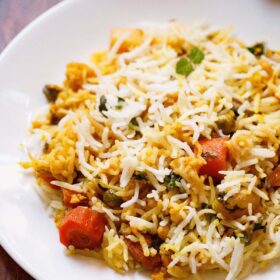
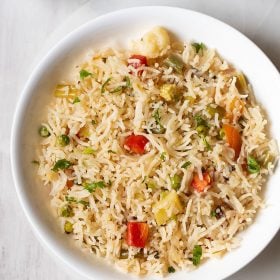
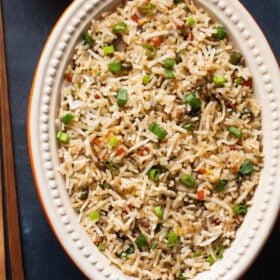
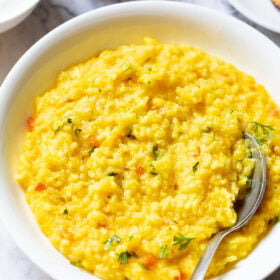








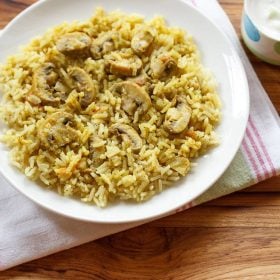
Came out perfect…..
Thanks a lot…..
Welcome Priya
thanks dassana for yet another tasty biryani recipe using seeramba rice.added peas,potatoes & brinjals & pressure cooked it.loved this flavourful spiced biryani.
welcome meveera. glad to know that you liked the biryani
Perfect for dinner. I used potato instead of mushrooms but turned out very tasty. Thanks for sharing.
Welcome Lalita. Thanks for sharing this info.
Hello Dassana di…I want to prepare this biryani for 15 persons…can u telHello Dassana di…I want to prepare this biryani for 15 persons…can u tell me the proportions of ingredients? ? Plzzz
samreen, just increase the recipe 5 times proportionately. also here you can add less turmeric powder, red chilli powder and coriander powder. basically add the spices powders so that there is balance in the dish.
Thank u Dassana di??
Hi Dassana di…today I tried dis biryani…instead of mushrooms I used green peas nd potatos…nd 1more change I made…I cooked it in pressure cooker on whistles. …nd it turned out really tasty…
Everyone in my house..my mom dad liked it a lot…its aroma was in the whole house?
Thnxx for delicious recepie…keep posting?
samreen, feels good to read your comment. nice to know that your mom and dad liked the biryani. yes it is aromatic and tastes good too. in fact any mix veggies can be added and peas & potatoes are a nice addition.
nice..
Thank you for the new recipe. I would like to know if I can use Indrayni rice for this recipe.Also, if u could help out in knowing the types of rice which is only meant for biryanis. I find it tough to try out new options when it comes to rice selections. Coz, as per my experience, some rice consume less water, some more, some get very soggy, some get half cooked. And this has been happening even after using a traditional method of cooking rice I.e Using proportionate water and rice in d pressure cooker. I realise the method of cooking is different for every rice type. N my realisation happens afte a month of using the rice type (lol). It becomes really hard, especially when I travel from state to another, while adapting the rice typetype available there, becomes a challenge.
welcome manasi. you can use indryani rice. for biryanis, in the north mostly basmati rice is used. in the lucknowi biryani tradition both sella basmati rice (parboiled basmati rice) and regular basmati rice are used. basmati rice has to be aged. if its aged, it yields a better texture after cooking. there are many varieties of basmati rice. usually i buy organic basmati rice or india gate classic basmati rice or dehradun basmati rice.
in the south, especially in tamil nadu seeraga samba rice is used. these are medium grained rice and have an aroma similar to cumin seeds. in maharashtra, there is a variety of rice called ambe mohur (mango blossom rice) which is used to prepare variety of rice dishes. ambe mohur has a fragrance similar to the mango blossoms. there are some indigenous rice varieties found in UP and bihar too, but i have never got a chance to explore them. in bengal, they use govindbhog rice for preparing various rice dishes.
you need to try cooking rice a couple of times and then you will now how much water and time does the rice take to cook. in fact basmati rice according to me is the fastest to cook. other varieties of rice like sona masuri etc take more time. also if the rice is hand pounded or brown rice or parboiled, then it takes more time to cook.
Wow Mam. Thank you so much for doing all the research for me. This is going to be very helpful. I just took a snapshot of it for my further reference. This shows you’re indeed a good cook, who’s aware of the taste and preferences of people all around India. Thanks again.
thank you manasi. i have not done any research. this is all from my cooking experience. since i have lived in different indian cities, i have some idea of the types of rice. in fact i missed telling you about the matta rice or the kerala red rice and also the goan red rice and not to forget the varieties of south indian parboiled rice. you should try this too. they have a different texture and taste as compared to the normal white rice.